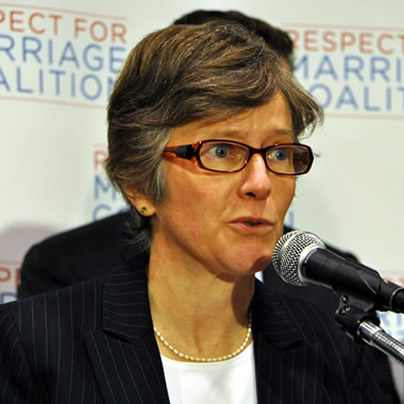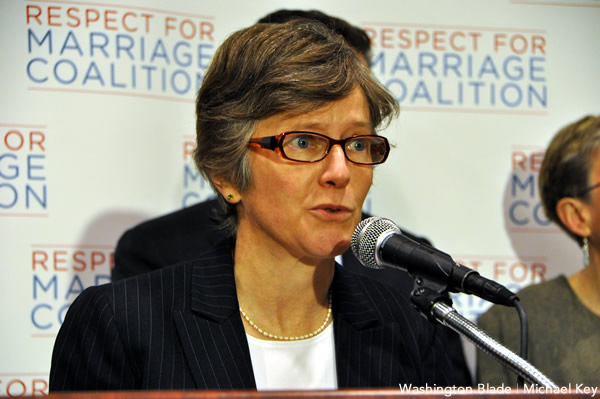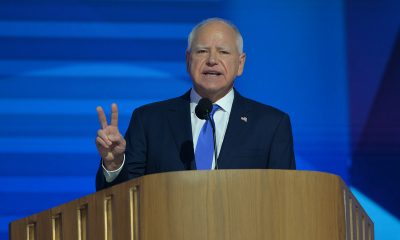News
10 years later, Goodridge decision still seen as milestone
Advocates see path for nationwide marriage equality in another decade


Mary Bonauto litigated the case that brought marriage equality to Massachusetts 10 years ago. (Washington Blade photo by Michael Key)
Ten years have passed since marriage equality came to the first state in the nation following a historic decision by the Massachusetts Supreme Court, helping to usher in swift change in attitudes and law around gay and lesbian couples.
On Nov. 18, 2003, the Massachusetts Supreme Court handed down a 4-3 ruling in the case of Goodridge v. Department of Public Health, bringing marriage equality to the Bay State.
“The question before us is whether, consistent with the Massachusetts Constitution, the Commonwealth may deny the protections, benefits, and obligations conferred by civil marriage to two individuals of the same sex who wish to marry,” the decision states. “We conclude that it may not. The Massachusetts Constitution affirms the dignity and equality of all individuals.”
Despite efforts from then-Gov. Mitt Romney to limit the ruling to civil unions and enact a constitutional amendment to rescind the decision, supporters of the ruling won the day and marriage equality has remained the law of the land in Massachusetts.
Mary Bonauto, who litigated the Goodridge case on behalf of Gay & Lesbian Advocates & Defenders and now serves as civil rights director there, said on the 10th anniversary of the decision the ruling “broke a historic barrier that we have never been able to overcome.”
“And it did so in the shared values of our constitution that we all believe in equality and we don’t have second-class citizens in this nation under the law,” Bonauto said.
The magnitude of the decision was bolstered, Bonauto said, six months later by the same-sex couples who went to the altar to marry.
“Now you had principle and you had reality working together, and all this freedom and equality from the court, and the you saw the joy in couples who finally were able to marry,” Bonauto said. “I think actually having couples marry was profound. It had to happen somewhere, somebody had to be first.”
Evan Wolfson, an early proponent of marriage equality and current president of Freedom to Marry, said having same-sex marriage legal someplace in the country was transformational for the movement.
“The breakthrough we were always working for in those early years was to make it real somewhere because we knew that once people had a chance to see with their own eyes families helped, and no one hurt, the opposition and resistance and fears would begin to subside, and we could build on that win to the rest of the wins still needed,” Wolfson said.
But the victory in Massachusetts, followed by then-San Francisco Mayor Gavin Newsom’s decision to distribute marriage licenses to gay couples, was met by a significant roadblock in the 2004 election when 11 states adopted constitutional amendments banning same-sex marriage. President George W. Bush won re-election after making support for a U.S. constitutional amendment banning same-sex marriage a prominent part of his campaign.
Pointing to political analysis debunking the notion that the marriage issue drove voters to the polls to re-elect Bush, Bonauto expressed skepticism that the ruling led to the win for Republicans in the 2004 election.
“The way this all got started, I think, people were putting two-and-two together about moral values, and the 22 percent of voters had stated that their most important consideration was ‘moral values,’ and the 11 amendments,” Bonauto said. “In the exit polling and so on about what this moral values means, for a great many people it meant the Iraq war. So it wasn’t even clear that the moral values voters were Bush voters.”
Bonauto said when she filed the case in 2001, 36 states already had statutory bans on same-sex marriage in response to advancing efforts to legalize same-sex marriage in Hawaii in the 1990s.
“From my perspective, it wasn’t really so much a backlash as a continued lashing,” Bonauto said. “People who had already taken steps to be very explicit about marriage bans, the only place they could go, continue to hone their political credentials, was to be even more draconian, and so that’s what happened by and large.”
Referencing a speech he delivered prior to Election Day of that year, Wolfson said the win in Massachusetts still trumped the losses at the ballot box in 2004 because it was still progress from the status quo.
“Even in 2004, I was on record before the election as saying that any year in which we endured some anti-gay attacks, but won marriage was a winning year because wins trump losses,” Wolfson said. “We would use the power of the win to overcome the temporary barriers erected in our losses, and that’s precisely what we are doing.”
It wasn’t until 2008 when other states would follow suit after courts in Connecticut and California ruled in favor of marriage equality, although the victory in California was (until recently) abrogated several months later by the passage of Proposition 8.
Now 16 states and D.C. are poised to have marriage equality on the books in the same year that the U.S. Supreme Court struck down Section 3 of the Defense of Marriage Act, which prohibited federal recognition of these unions.
The ruling against DOMA at the Supreme Court was coupled by a decision from justices that restored marriage equality to California. In the months that followed, the New Jersey Supreme Court has instituted marriage equality in the Garden State and state legislatures in Illinois and Hawaii have extended marriage to gay couples. At any time, the New Mexico Supreme Court could hand down a ruling in favor of marriage equality as a result of pending litigation.
M.V. Lee Badgett, research director at the Williams Institute, estimated about 100,000 gay couples have married since the Goodridge decision 10 years ago, but the effect of having marriage equality in Massachusetts and other places goes far beyond numbers.
“It will take a while for researchers to analyze and publish more detailed findings on the effects of the ability to marry and of actual marriage,” Badgett said. “One early study showed that same-sex couples in Massachusetts feel more social inclusion, and one sample of gay men showed lower health care costs and health care utilization. In California we’ve seen that psychological health is better for same-sex couples who marry or had domestic partnerships.”
Wolfson said the growth of marriage equality in the country is noteworthy in many respects, including in terms of percentages.
“As we celebrate the end of this big year, we now have 38 percent of the American people living in a freedom to marry state, up from zero a decade ago,” Wolfson said. “Gay people can share in the freedom to marry in 18 countries, in five continents, up from zero virtually a decade ago. That, by any standard, is enormous progress and real momentum, but we have to finish the job.”
Reflecting back on the decision 10 years ago, Bonauto said she hoped at the time this much change would happen a decade later, but confessed “there were times that I certainly wasn’t sure.”
“I had always hoped that the arc for us would be what it was in some ways for interracial marriage, where courts rebuff and rebuff and rebuff, and then in 1948 the California Supreme Court struck down the interracial marriage ban,” Bonauto said. “More states repealed those after the California ruling, so that 19 years later when the Supreme Court decided Loving v. Virginia, Virginia was only one of 16 states that had such bans.”
During a news conference held on the same day as the 10th anniversary of the Goodridge decision, White House Press Secretary Jay Carney also noted progress made in the past decade in response to a more general question on LGBT rights.
“I think that anybody who looks at LGBT rights and the road travelled in this country just in the past decade would rightly be pleased by the significant progress that’s been made, even as we acknowledge that more work needs to be done, more progress need to be done,” Carney said.
Carney later told the Blade via email he wasn’t making a direct reference to the Goodridge decision, but his comments were meant “just as a broad reference to the progress made over the last decade.”
And hopes continue for a brighter future as advocates anticipate one of the pending federal lawsuits in 20 states across the country will make its way to the Supreme Court, delivering a ruling in favor of same-sex marriage nationwide in less than 10 years. Following the Supreme Court rulings in June, Chad Griffin, president of the Human Rights Campaign, said marriage equality will reach the entire nation within five years.
Bonauto said she hopes the Supreme Court will settle the marriage issue once and for all, but isn’t completely sure which way the justices would rule and emphasized hard work is necessary for a favorable outcome.
“I think we have to work with the same intensity that we have up to this point and hopefully the Supreme Court will settle the issue, and then if for some reason it does not, which I think would be extremely unfortunate, I just think we have to continue doing what we’ve been doing state by state,” she said.
Freedom to Marry has prepared a “Roadmap to Victory” in anticipation of a Supreme Court decision that entails winning more states and building support for same-sex marriage in nationwide polls. Eyes will be on Oregon in 2014 to see whether it will reverse a constitutional ban on same-sex marriage at the ballot.
Wolfson said he “absolutely” believes that supporters of same-sex marriage will be able to finish the job.
“The good news for us is the same winning strategy that brought us to this point of momentum is the strategy that is going to bring it all home,” Wolfson said.
Minnesota
Reports say woman killed by ICE was part of LGBTQ community
Renee Nicole Good shot in Minneapolis on Wednesday

A U.S. Immigration and Customs Enforcement agent shot and killed a woman in Minneapolis as she attempted to drive away from law enforcement during a protest on Wednesday.
The Star Tribune newspaper identified the victim as Renee Nicole Good, 37, a Minneapolis resident who lived blocks from where she was shot in the Central neighborhood, according to reports. Donna Ganger, Good’s mother, told the Star Tribune that her daughter lived in the Twin Cities with her wife.
Multiple videos of the shooting have gone viral on social media, showing various angles of the fatal incident — including footage that shows Good getting into her car and attempting to drive away from law enforcement officers, who had their weapons drawn.
In the videos, ICE agents can be heard telling Good to “get out of the fucking car” as they attempted to arrest her. Good, who press reports say was married to a woman, ended up crashing her car into an electric pole and other vehicles. She was later transported from the scene of the shooting and died at the hospital.
President Donald Trump defended the ICE agent on Truth Social, saying the officer was “viciously” run over — a claim that coincides with Homeland Security Secretary Kristi Noem’s assessment of the situation. Noem, a South Dakota Republican, insisted the officer “fired defensive shots” at Good after she attempted to run over law enforcement agents “in an attempt to kill them — an act of domestic terrorism.”
Multiple state and local officials disputed claims that the shooting was carried out in self-defense at the same time Noem was making those assertions.
An Instagram account that appears to belong to Good describes her as a “poet and writer and wife and mom and shitty guitar strummer from Colorado; experiencing Minneapolis, MN,” accompanied by a rainbow flag emoji.
A video posted to X after the shooting shows a woman, reportedly her wife, sitting on the ground, crying and saying, “They killed my wife. I don’t know what to do.”
“We’ve dreaded this moment since the early stages of this ICE presence in Minneapolis,” Mayor Jacob Frey said during a Wednesday press conference. “Having seen the video myself, I want to tell everybody directly that [the DHS’s claim of self-defense] is bullshit. This was an agent recklessly using power that resulted in somebody dying, getting killed.”
“I have a message for ICE. To ICE, get the fuck out of Minneapolis,” Frey continued. “We do not want you here. Your stated reason for being in this city is to create some kind of safety, and you are doing exactly the opposite. People are being hurt. Families are being ripped apart. Long-term Minneapolis residents that have contributed so greatly to our city, to our culture, to our economy are being terrorized, and now somebody is dead. That’s on you, and it’s also on you to leave.”
Across the Capitol, members of the House and the Senate condemned the actions of the officer.
“There’s no indication she’s a protester, there’s nothing that at least you can see on the video, and therefore nothing that the officers on the ground could see that identify her as someone who’s set out to try to do harm to an ICE officer,” U.S. Sen. Elizabeth Warren (D-Mass.) said Wednesday night on MS NOW’s “The Weeknight.”
“There is no evidence that has been presented to justify this killing,” House Minority Leader Hakeem Jeffries (D-N.Y.) said in a statement on his website. “The masked ICE agent who pulled the trigger should be criminally investigated to the full extent of the law for acting with depraved indifference to human life.”
“ICE just killed someone in Minneapolis,” U.S. Rep. Robert Garcia (D-Calif.) the highest-ranking Democrat on the House Oversight Committee, posted on X. “This administration’s violence against communities across our country is horrific and dangerous. Oversight Democrats are demanding answers on what happened today. We need an investigation immediately.”
In a statement to the Advocate, Human Rights Campaign President Kelley Robinson wrote, “Today, a woman was senselessly killed in Minneapolis during an ICE action — a brutal reminder that this agency and the Trump regime put every community at risk, spreading fear instead of safety. Reports that she may have been part of the LGBTQ+ community underscore how often the most vulnerable pay the highest price.”
National LGBTQ Task Force President Kierra Johnson also responded to Good’s death.
“We recognize and mourn the loss of Renee Nicole Good and extend our condolences to her family, loved ones, and community,” said Johnson in a statement. “This loss of life was preventable and reprehensible, particularly coming at the hands of federal agents.”
National
U.S. in midst of ‘genocidal process against trans people’: study
Attacks rooted in Nazi ideology’s views on gender

Earlier this week, the Lemkin Institute for Genocide Prevention and Human Security issued a haunting warning. Dr. Elisa von Joeden-Forgey, president of the Lemkin Institute, stated that the U.S. is in the “early-to-mid stages of a genocidal process against trans and nonbinary and intersex people.” Dr. Gregory Santon, former president of the International Association of Genocide Scholars, flags “a hardening of categories” surrounding gender in a “totalitarian” way.
Stanton argues that this is rooted in Nazi ideology’s surrounding gender — this same regime that killed many LGBTQIA individuals in the name of a natural “binary.” As Von Joeden-Forgey said, the queer community, alongside other “minority groups, tends to be a kind of canary in the coal mine.”
In his first year in office, Trump and his Cabinet’s anti-trans rhetoric has only intensified, with a report released late September by journalist Ken Klippenstein in which national security officers leaked that the FBI is planning to classify trans people as “extremists.” By classifying trans people as “Nihilistic Violent Extremists,” far-right groups would have more “political (and media) cover,” as Abby Monteil reports for them, for anti-trans violence and legislation.
While the news is terrifying, it’s not unprecedented – the fight against trans rights and classification of trans people as violent extremists was included in Project 2025, and in the past several weeks, far-right leaders’ transphobic campaign has expanded: boycotting Netflix to pressure the platform to remove trans characters, leveraging anti-trans attack ads in the Virginia governor’s race and banning professors from acknowledging that trans people exist. In fact last month, two Republican members of Congress called for the institutionalization of trans people.
It’s a dangerous escalation of transphobic violence that the Human Rights Campaign has classified as an epidemic. According to an Everytown for Gun Safety report published in 2020, the number of trans people murdered in the U.S. almost doubled between 2017 and 2021. According to data released by the Gun Safety report from February 2024, 34 percent of gun homicides of trans, nonbinary, and gender expansive people remain unsolved.
As Tori Cooper, director of Community Engagement for the Transgender Justice Initiative for the Human Rights Campaign Foundation, this violence serves a purpose. “The hate toward transgender and gender expansive community members is fueled by disinformation, rhetoric and ideology that treats our community as political pawns ignoring the fact that we reserve the opportunity to live our lives full without fear of harm or death,” Cooper said.
“The genocidal process,” Von Joeden-Forgey said, “is really about destroying identities, destroying groups through all sorts of means.” And just like the Nazi regime, former genocide researcher Haley Brown said, the Trump administration is fueling conspiracy theories surrounding “cultural Marixsm” — the claim that leftists, feminists, Marxists, and queer people are trying to destroy western civilization. This term, Brown states, was borrowed directly from the Nazi’s conspiracies surrounding “Cultural Bolshevism.”
As Brown explains, historians are just beginning to research the Nazis’ anti-trans violence, but what they are finding reveals a terrifying pattern wherein trans people are stripped of their identification documents, arrested and assaulted, and outright killed.
Before World War II, Germany – especially Berlin – was a hub for transgender communities and culture. In 1919, Dr. Magnus Hirschfield, a Jewish gay sexologist and doctor, founded the Institut für Sexualwissenschaft, the Institute for Sexual Science. The Institute was groundbreaking for offering some of the first modern gender-affirming healthcare, with a trans-affirming clinic and performing some of the first gender-affirming surgeries in the 1930s for trans women Dora Richter and Lili Elbe.
Researchers at the institute coined the term “trassexualism” in 1923, which while outdated now, was the first modern term that Dr. Hirschfield used when working with Berlin police to acquire “transvestite passes” for his patients to help them avoid arrest under public nuisance and decency laws. During the Weimar Republic, trans people could also change their names although their options were limited. In Berlin, queer press flourished after World War I along with a number of clubs welcoming gay, lesbian and trans clientele, including Eldorado, which featured trans performers on stage.
But as Hitler rose to power, trans people were targeted. In 1933, Nazi youth and members of the Sturmabteilung ransacked the institute, stealing and burning books – one of the first book burnings of the Nazi regime. German police stopped recognizing the “transvestite” passes and issuing new ones, and under Paragraph 175, which criminalized sexual relationships with men, trans women (who were misgendered by the police) were arrested and sent to concentration camps.
As the Lemkin Intsitute for Genocide Prevention and Human Security wrote in a statement:
“The Nazis, like other genocidal groups, believed that national strength and existential
power could only be achieved through an imposition of a strict gender binary within the racially pure ‘national community.’ A fundamentalist gender binary was a key feature of Nazi racial politics and genocide.”
History professor Laurie Marhoefer wrote for The Conversation that while trans people were targeted, there was not extensive discussion of them by the regime. But there was evidence of the transphobia behind the regime’s violence, specifically in Hermann Ferdinand Voss’s 1938 book “Ein Beitrag zum Problem des Transvestitismus.”Voss noted that during the Nazi regime, trans people could and were arrested and sent to concentration camps where they underwent forced medical experimentation (including conversion therapy and castration) and died in the gas chambers.
While there is growing recognition that gay, bisexual, and lesbian individuals were targeted during the Holocaust, few know about the trans genocide through which trans individuals were arrested, underwent forced castration and conversion therapy, and were outright killed alongside gay, lesbian, disabled and Jewish individuals in concentration camps. Historians are just beginning to undertake this research, writes Marhoefer, and to delve further into the complex racial hierarchies that affected how trans people were treated.
As Zavier Nunn writes for Past & Present, trans people of “Aryan” racial status and those not considered to be homosexuals were sometimes spared from the worst violence and outright murder. Depending on their skills, they could even be considered for rehabilitation into the Volksgemeinschaft, or Nazi utopian community. As Nunn highlights, trans violence was much more nuanced and individualized and should be explored separately from violence against gay and lesbian individuals during the Holocaust.
Marhoefer’s research of violence against trans women, as recorded in police files (as is the persecution of gay and lesbian individuals), is groundbreaking but rare. He gave a talk at the Museum of Jewish Heritage in 2023, shortly after a 2022 civil lawsuit about denial that trans people were victims of the Holocaust. The German court recognized that trans people were victimized and killed by the Nazi regime, but in the United States, there is still a hesitancy by the wider LGBTQ community and leftist groups to acknowledge that we are living during a time of anti-trans violence, that trans people are being used as political scapegoats in order to distract from real problems of accountability and transparency around government policy.
As anti-trans legislation escalates, it’s important to remember and call out how trans violence is not only a feminist issue, it’s a human rights one as well. While Shannon Fyfe argues that the current campaigns against trans people may not fit the traditional legal definition of a genocide, the destruction and denial of life saving care, access to public spaces, and escalating violence is still immensely devastating.
Kaamya Sharma also notes that the term “genocide” has deep geo-political implications. As she explained, “western organisations are, historically and today, apathetic to the actual lives of people in the Global South, and put moral posturing above Brown and Black lives,” so the choice to use “genocide” is a loaded one. But as the Lemkin Institute for Genocide Prevention and Human Security writes in the same statement: “The ideological constructs of transgender women promoted by gender critical ideologues are particularly genocidal. They share many features in common with other, better known, genocidal ideologies. Transgender women are represented as stealth border crosses who seek to defile the purity of cisgender women, much as Tutsi women were viewed in Hutu Power ideology and Jewish men in Nazi antisemitism.”
Trans people are not extremists, nor are they grooming children or threatening the fabric of American identity – they are human beings for whom (like all of us) gender affirming care is lifesaving. As we remember the trans lives lost decades ago and those lost this year to transphobic violence, knowing this history is the only way to stop its rewriting.
Virginia
Gay Va. State Sen. Ebbin resigns for role in Spanberger administration
Veteran lawmaker will step down in February

Alexandria Democrat Adam Ebbin, who has served as an openly gay member of the Virginia Legislature since 2004, announced on Jan. 7 that he is resigning from his seat in the State Senate to take a job in the administration of Gov.-Elect Abigail Spanberger.
Since 2012, Ebbin has been a member of the Virginia Senate for the 39th District representing parts of Alexandria, Arlington, and Fairfax counties. He served in the Virginia House of Delegates representing Alexandria from 2004 to 2012, becoming the state’s first out gay lawmaker.
His announcement says he submitted his resignation from his Senate position effective Feb. 18 to join the Spanberger administration as a senior adviser at the Virginia Cannabis Control Authority.
“I’m grateful to have the benefit of Senator Ebbin’s policy expertise continuing to serve the people of Virginia, and I look forward to working with him to prioritize public safety and public health,” Spanberger said in Ebbin’s announcement statement.
She was referring to the lead role Ebbin has played in the Virginia Legislature’s approval in 2020 of legislation decriminalizing marijuana and the subsequent approval in 2021of a bill legalizing recreational use and possession of marijuana for adults 21 years of age and older. But the Virginia Legislature has yet to pass legislation facilitating the retail sale of marijuana for recreational use and limits sales to purchases at licensed medical marijuana dispensaries.
“I share Governor-elect Spanberger’s goal that adults 21 and over who choose to use cannabis, and those who use it for medical treatment, have access to a well-tested, accurately labeled product, free from contamination,” Ebbin said in his statement. “2026 is the year we will move cannabis sales off the street corner and behind the age-verified counter,” he said.
-

 Sponsored4 days ago
Sponsored4 days agoSafer Ways to Pay for Online Performances and Queer Events
-

 District of Columbia4 days ago
District of Columbia4 days agoTwo pioneering gay journalists to speak at Thursday event
-

 a&e features4 days ago
a&e features4 days agoQueer highlights of the 2026 Critics Choice Awards: Aunt Gladys, that ‘Heated Rivalry’ shoutout and more
-

 Colombia3 days ago
Colombia3 days agoBlade travels to Colombia after U.S. forces seize Maduro in Venezuela



















